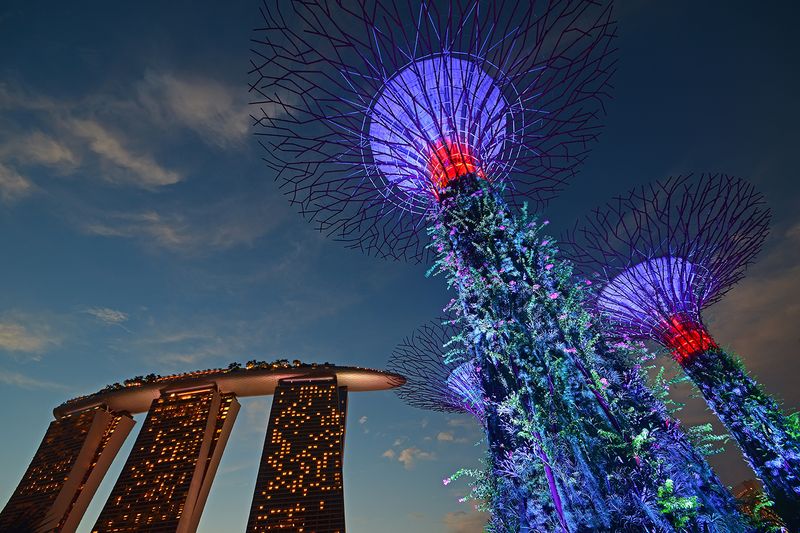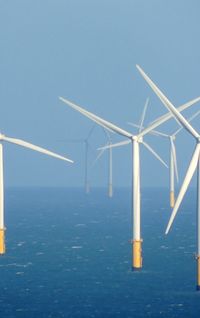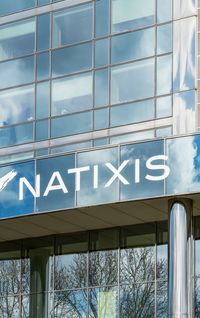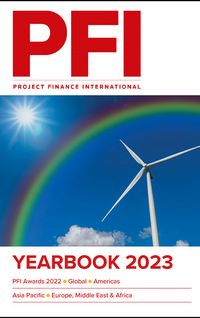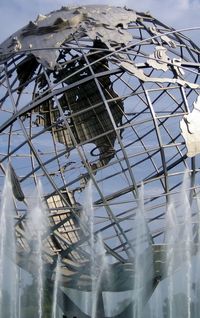Bank of the Year – Westpac
Westpac had a particularly stellar presence in major greenfield project financings in both Australia and New Zealand, in a stand-out year for the region. The Australasian region in the first nine months of 2022 was placed third after North America and Western Europe, and was up 46% in PF loans volume terms compared with Q1–Q3 2021.
As of Q3, Westpac had climbed up to seventh in PFI’s Asia-Pacific PF loan league tables, an impressive top-10 position considering the field includes many banks active across the entire region. The position is much improved on the 12th ranking last year, with Westpac expecting a robust Q4 to end 2022.
Jason Tranter is global head of project finance, working with David Scrivener, global head of energy, infrastructure and resources.
Particularly notable greenfield projects included TagEnergy’s fully merchant 756MW Golden Plains Wind Farm Stage One, with Westpac one of four commercial banks on the A$725m loan. It is said to be the first fully merchant wind farm project financed in Australia since Westpac financed Woodlawn wind in 2011.
Westpac was one of just three commercial banks financing a standalone big battery this year, for Edify Energy and Federation Asset Management’s 150MW/300MWh Riverina & Darlington Point BESS. The A$140m non-recourse loan was only the second commercial bank project financing of a standalone utility-scale battery in Australia to-date.
Lightsource bp financed a 515MW pair of solar farms, via a A$540m green loan from five banks. Westpac was a green loan coordinator.
Westpac had a strong year in neighbouring New Zealand as sole lender for a solar portfolio financing. Westpac lent a NZ$150m single finance facility for five construction-stage projects that Kiwi company Lodestone Energy is developing. Westpac was also one of two joint lead managers for Auckland Airport’s NZ$225m bond issue, and the only arranger for Christchurch Airport’s NZ$100m bond offering.
Westpac featured on many renewables refinancings, including the 228MW Lal Lal wind, 72MW Emerald Solar, 125MW Clare Solar, 275MW Darlington Point Solar, Infrastructure Capital Group’s combined 300MW wind and hydro portfolio refinancing from two lenders, and another unusual refinancing combining debt for a wind farm and gas peaker for Nexif Energy.
Westpac was present in large bank groups on major debt transactions for ports and airports, land and motor registry financings, Pluto LNG Train 2, remote power companies Zenith Energy and Pacific Energy, telecoms towers, fibre company Uniti, smart meters company Intellihub, and West Musgrave copper-nickel mine.
Green Deal of the Year – Renew Power RTC
Indian renewables developer ReNew Power financed the country’s largest round-the-clock (RTC) green energy project with a US$985m green loan facility from international banks. This represents the first project financing of a renewable generation and battery RTC project, blazing a trail for increasingly popular RTC power purchasing and battery storage. The deal participants claim it also was the largest external commercial borrowing facility for a single Indian renewables project.
The 1.3GW wind-solar-battery project is backed by the first RTC power purchase agreement awarded by the Indian government. ReNew won all the capacity in Solar Energy Corp of India’s first 25-year RTC auction in 2020. The 400MW PPA was signed in 2021 at a starting tariff of Rs2.90 per kWh, rising by 3% annually for 15 years then stabilising.
The project will feature 900MW of wind, 400MW of solar and 50MW/100MWh of battery storage, spread across sites in Karnataka, Rajasthan and Maharashtra. Construction started in H1 2022 and commissioning is expected for the first stages in Q3 2023. With only 400MW of RTC power contracted, but the project oversized to ensure constant energy supply, it will also trade in the merchant market.
ReNew Power attracted a third-party equity provider to the US$1.35bn project, with Mitsui & Co from Japan joining as a 49% minority equity sponsor.
Rabobank was mandated lead arranger for the senior partially amortising project loan, with a five-year tenor. The 11 lenders that joined during a 1.4 times oversubscribed syndication were: BNP Paribas, Credit Agricole, DBS, Intesa Sanpaolo, Natixis, Mizuho Bank, MUFG, NordLB, Siemens Bank, Societe Generale and Sumitomo Mitsui Banking Corporation. For seven of the lenders, it was their first time working with ReNew Power. Debt pricing is in the range of 225bp–250bp above six-month SOFR.
Rabobank, Mizuho, Natixis and SMBC were green loan coordinators.
A rupee loan alternative was explored concurrently with the US dollar financing, but the dollar loan made it across the line first. The debt is expected to ultimately be refinanced in the bond market. Envision Energy and Siemens Gamesa are providing wind turbines, while Fluence is providing the lithium-ion battery.
Luthra & Luthra was ReNew’s legal adviser on the project financing. Cyril Amarchand Mangaldas and Norton Rose Fulbright advised the lenders. DSK Legal advised ReNew on the equity deal with Mitsui & Co, while Trilegal and Dentons represented Mitsui.
Renewables Deal of the Year – Golden Plains
TagEnergy, a newcomer in the competitive Australian renewables market, closed a project financing for the A$1.975bn Golden Plains Wind Farm Stage One, among the country’s largest wind farms to enter construction and the largest in the state of Victoria. More unusually, TagEnergy has done so on a fully merchant basis, understood to be only the second to do so since 2011.
The Golden Plains wind farm’s first stage will have 756MW of capacity, with 122 of Vestas’s V162-6.2MW EnVentus turbines. These turbines are among the largest on the market globally and have the largest rotor size in Vestas’ turbine portfolio. The project will be Vestas’ biggest onshore wind farm in Asia-Pacific, generating enough clean energy for roughly 450,000 homes. A co-located 300MW battery is in planning, and a second stage should increase the wind farm’s size by 500MW.
The project’s leverage is around 37%, with a A$725m loan with tenors of five and eight years. The conservatively sized debt financing could later be upsized if the project signs power purchase agreements. TagEnergy is sole equity provider for the remaining A$1.25bn.
The mandated lead arrangers are Asian and Australian commercial banks and Bank of China, Commonwealth Bank of Australia, Mizuho Bank and Westpac, as well as government lenders and export credit agencies Eksport Kredit Fonden (EKF) from Denmark, KfW IPEX-Bank from Germany and Clean Energy Finance Corporation (CEFC) from Australia. The Australian federal government’s CEFC said it lent A$175m.
The project is TagEnergy’s first Australian investment, joining a 3GW portfolio of onshore wind, solar and battery storage projects in the UK, Portugal, Spain, France and Australia. Formed in 2019, TagEnergy is majority owned by French diversified investment company Impala SAS Group. In April, TagEnergy received a €450m capital injection from French fund managers Mirova and Omnes Capital.
EPC contractor Vestas said its owns Asia-Pacific financial solutions team brought Danish export credit agency EKF into the project early on. Vestas has provided a 30-year service and maintenance agreement.
Westwind Energy, owned by Germany-based Westwind Group, was original developer of the project before selling it to TagEnergy. Westwind will have a long-term asset management role and work with TagEnergy on developing the second stage wind and battery projects. Golden Plains Wind Stage One went through the state’s highest level of environmental scrutiny, an Environment Effects Statement.
White & Case was the sponsor’s legal adviser, King & Wood Mallesons was lenders’ legal counsel, and Elgar Middleton was financial adviser.
LNG Deal of the Year – Pluto LNG Train 2
The US$5.6bn Pluto LNG Train 2 project in Western Australia is the largest construction project financing transaction to close in the Australian market in 2022. A US$3.48bn loan attracted more than 30 lenders from Asia-Pacific and Europe. Banks joining said they were supporting gas as part of the global energy transition.
Pluto LNG Train 2 will be designed to process up to 8m tonnes per year of LNG from Woodside Energy’s planned US$5.7bn Scarborough offshore gas field. Operator Woodside made final investment decisions simultaneously in November 2021 for both the Scarborough gas field and Pluto LNG Train 2.
US-based fund manager Global Infrastructure Partner (GIP) has made its first Australian investment in an LNG construction project, after a couple of recent purchases of operational assets. In taking a 49% equity share, GIP took responsibility for funding that proportion of construction costs.
US-based Bechtel is engineering, procurement and construction contractor with a capital expenditure estimate of US$5.6bn.
Woodside put together a tailored solution to suit GIP’s risk appetite.
GIP will finance up to US$835m of cost overruns, but Woodside will cover any costs beyond that. GIP will be compensated if it is exposed to Scope 1 greenhouse gas emissions liabilities above an agreed baseline. If the status of key regulatory approvals materially changes, GIP could sell back to Woodside.
Woodside says Scarborough gas has a much lower carbon dioxide percentage than other Australian LNG projects, at 0.1% reservoir CO2, and that the new train will use aero-derivative gas turbines for liquefaction and inlet air chilling, providing higher thermal efficiency and lower greenhouse gas emissions.
GIP’s project company raised a US$3.48bn seven-year loan maturing in 2029. It offers a 190bp interest rate margin during construction, stepping down to 170bp in operations.
National Australia Bank (NAB) took a leading role in arranging the finance as intercreditor agent.
The mandated lead arrangers and bookrunners are Australia & New Zealand Banking Group (ANZ), HSBC, Intesa Sanpaolo, Mizuho Bank, Westpac, Sumitomo Mitsui Banking Corporation, United Overseas Bank, Bank of China, MUFG, NAB, Societe Generale, Korea Development Bank, Credit Agricole, Santander, Natixis, ICBC, NordLB and Standard Chartered.
Syndication attracted 13 lenders: CaixaBank, Deutsche Bank, Kookmin Bank, Norinchukin Bank, China Everbright Bank, DZ Bank, Chang Hwa Commercial Bank, E.Sun Commercial Bank, Hua Nan Commercial Bank, Taiwan Business Bank, Woori Bank, Bank of Communications and Shinhan Bank.
Allens was GIP’s legal adviser, while Clifford Chance advised the lenders. Ashurst advised Woodside. RPS was technical and ESG adviser.
PPP Deal of the Year – Frankston
The Frankston Hospital Redevelopment PPP is a major overhaul and expansion of an aging public hospital to cater to a growing population on the south-east fringes of Melbourne. Victoria has embraced the PPP model for hospitals, with this its seventh. The highly competitive debt financing featured all-international banks from North America, Asia and Europe, with long-term tenors stretching from 10 to 20 years. The loan is also certified as a "sustainability loan", a relatively new class of loan that meets both "green loan" and "social loan" credentials.
The expanded hospital will have 130 more beds, taking the total to 443, and new facilities including new operating theatres, maternity, obstetrics and paediatric facilities, mental health zones and new car parking. The state estimates the improved hospital would be able to treat 35,000 more patients per year. The Exemplar Health consortium will maintain it for a 25-year operating period, receiving availability-based payments from the Victoria Health Building Authority. Frankston Hospital will enter operations in a staged manner from 2025 to 2027, without interruptions to healthcare.
Exemplar Health brings together Capella Capital as financial adviser, Aware Super as equity investor, Lendlease as equity investor and construction contractor, and maintenance contractors Honeywell and Compass Group. The consortium beat two other shortlisted final bidders.
Exemplar Health raised A$1.08bn of construction and term loans and debt service reserve facilities. The tenors are 10, 15 and 20 years. The notional tenor is more than 24 years, with amortisation commencing only after construction. Mandated lead arrangers are Canadian Imperial Bank of Commerce, Credit Agricole, Credit Industriel et Commercial, DZ Bank, Standard Chartered Bank and Sumitomo Mitsui Trust Bank. Debt pricing is in the range of 100bp–200bp above BBSY.
Credit Agricole, CIBC and Standard Chartered were sustainability loan coordinators. The loan meets the Asia Pacific Loan Market Association’s green loan principles and social loan principles. Qualifying features included carbon-neutral energy consumption for the new tower, energy and water savings, electric vehicle charging and A$14.4m of spending with aboriginal businesses in Victoria.
Advisers were law firms Norton Rose Fulbright for the sponsors, Allens for lenders, North as technical adviser, EY as tax adviser, BDO as model adviser and Professional Risk Solution as insurance adviser. The grantor VHBA’s advisers included MinterEllison, legal and KPMG, financial.
Power Deal of the Year – Hin Kong
Coal is bad but gas may not be as bad as a transition fuel in the current climate that is pushing for clean energy. However, gas has already started to see financial institutions avoiding it like a plague and steering away from it.
Despite this, Ratch Group (51%) and Gulf Energy Development (49%) are bucking the trend. They have successfully raised a dual-currency US$770m loan facility with a long 23-year tenor to finance the development of the 1.4GW combined cycle Hin Kong power plant. The loan is the first project finance facility secured under Thailand’s liberalised gas import policy, and the first Thai IPP with a non-PTT gas importer. It is the PFI Asia Pacific Power Deal of the Year.
The lending group comprises Bank of China, ICBC, Mizuho, SMTB Singapore, Natixis, Societe Generale, Standard Chartered and OCBC on the US dollar tranche, while the baht tranche has Bank of Ayudhya, Bangkok Bank, Government Savings Bank, Siam Commercial Bank, SMBC, and SMTB Thailand. Legal advisers are Baker McKenzie for the borrower and Linklaters for the lenders.
The deal is probably the first facility to suffer the selective gas lending of development banks as they put a priority on cleaner energy and recognising the need for transition energy in less developed countries. Thailand is considered a developing country, enjoying one of the largest economies in South-East Asia. It has a free market economy with relatively well-developed infrastructure.
Thus, during the financing journey multilaterals that had initially committed to the deal were seen dropping out. However, the sponsors were soon able to attract other commercial banks to join, completed its banking group, signed the loan, and achieved financial closing.
The project is the first gas-fired power plant being developed in the country, and in the region, in a long while. It taps natural gas as fuel, supplied under a long-term gas sales agreement signed with Hin Kong Power Holding Co, one of the newly licensed natural gas importers under the liberalised policy, which has dissolved PTT’s monopoly. EGAT, the offtaker, is providing a guarantee on the gas supply – a feature that comforts the lenders. A consortium of MHI, Sino-Thai Engineering & Construction and Mitsubishi Power was awarded a full turnkey engineering, procurement and construction (EPC) contract.
Offshore Wind Deal of the Year – Ishikari
The offshore wind industry is booming in the region and the wind farms provide a sustainable solution in replacing coal-fired power plants. Japan has embraced it and the latest offshore wind project even comes with battery storage. The Ishikari integrated offshore wind and battery storage project, a global first, is PFI Asia Pacific Offshore Wind Deal of the year.
Pattern Energy and its affiliate in Japan, Green Power Investment Corp, are developing the 112MW Ishikari offshore wind project about three kilometres from the shore of Ishikari Bay in Hokkaido. The project includes a battery storage component with a 100MW/180MWh capacity, making the integrated offshore wind and battery storage project a global first for the energy industry. At the same time, it is Japan’s largest combined offshore wind and power storage facility, setting a key milestone in the country’s energy transition.
The project is one of the limited industry-scale wind projects that are being developed outside of the offshore wind auction launched last year and outside another auction scheduled to be launched before the year-end. Construction, which will utilise fourteen 8.0MW Siemens Gamesa wind turbines built specifically for offshore use, has started and is expected to achieve commercial operation date (COD) in December 2023. It will enjoy a feed-in tariff of ¥36/kWh (US$0.2523/kWh) for 20 years with Hokkaido Electric Power as the offtaker.
The two partners raised a ¥66.6bn (US$454m) 19-year project financing for Green Power Ishikari, the project company. The joint lead arrangers – Development Bank of Japan, Mizuho Bank, MUFG, Shinsei Bank, Societe Generale, Sumitomo Mitsui Banking Corp, and Sumitomo Mitsui Trust Bank – signed the loan in August 2022. The loan was syndicated and was oversubscribed, attracting 21 institutions (local banks, trust banks, insurance companies, etc ) – an indication of the strong appetite for offshore wind projects in Japan.
The sponsors had Baker McKenzie as legal adviser, while the lenders had Nishimura & Asahi and Torys. Lenders also had Mott McDonald as technical adviser and E&S adviser; Willis Towers Watson as insurance adviser; and Tokyo Kyodo Accounting Office as model auditor.
Battery Deal of the Year – Hartree
Battery storage will play a key role in Taiwan’s renewable energy sector in providing intermittent power supply and will also play a key role in transition energy.
A consortium led by Hartree Partners of the US is developing the first stand-alone battery storage project in the country that does not have a link to any power generation plant.
It has secured a US$50m five-year limited recourse loan to finance the development of the project. The facility is PFI Asia Pacific Battery Deal of the Year.
The loan, based on a 80:20 debt-to-equity ratio, is provided by Cathay United Bank and HSBC which may sell down their portions at a later stage. The legal advisers are DLA Piper for the borrower and Herbert Smith Freehills for the lenders.
The borrower is CHC, in which Hartree has a 45% stake, and its partners are Chinese lithium-ion battery manufacturer CATL (30%) and Cathay Fortune Corp (25%) which is owned by Chinese billionaire Yu Yong and is one of the biggest solar companies in China. CATL is the world’s largest battery maker with a 35% market share globally. The EPC contractor is the Taiwanese unit of Hartree.
The project structure has fully merchant risk, as the project joins the half-hourly bidding in the market and is the first to do so. But being the only bidder, there is basically no competition, and thus the merchant risk aspect is almost negligible unless new players join in the future. To-date, it is the only storage battery project participating in the market, helping regulate the power supply to the grid.
Energy storage will become more important as the smart grid and renewable sectors grow. Taiwan aims to have a total of 590MW of battery storage by 2025, with a target of 160MW to be managed and procured by state-owned TaiPower and 430MW to be developed by the private sector. The country aims to have renewable energy make up 20% of its energy mix by 2025.
To see the digital version of this report, please click here
To purchase printed copies or a PDF of this report, please email leonie.welss@lseg.com
